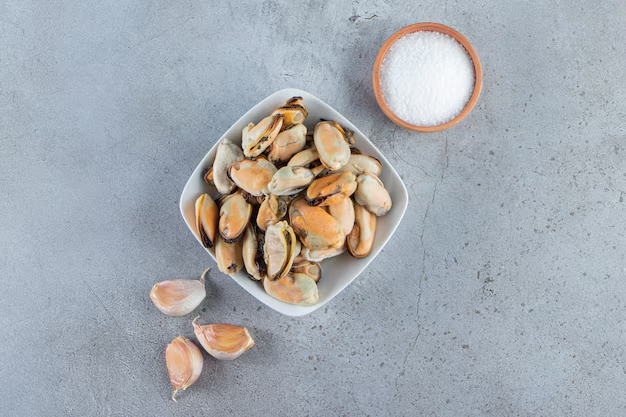How Long Can You Safely Store Scallops in the Refrigerator?
Fresh, the oceanic treasures known as scallops are beloved for their delicate texture and sweet, buttery flavor. Whether seared to perfection or marinated as a culinary masterpiece, understanding how to properly store them is paramount to preserving their quality and, more importantly, ensuring they are safe to consume. 🌊 This guide delves into the expected refrigerator shelf life of scallops, alongside essential storage tips and the signs to watch for when they're no longer suitable for your plate.
Understanding the Lifespan of Scallops in the Refrigerator
Fresh Scallops: The Clock Starts Ticking
Fresh scallops, when purchased, give you a small window of opportunity to enjoy their best qualities. Typically, fresh scallops can be stored in your fridge for one to two days. Here’s why:
- Temperature Sensitivity: Scallops are quite sensitive to temperature fluctuations. The optimal temperature for storing scallops is at 32°F (0°C), slightly colder than most fridge settings. Without proper temperature control, their quality diminishes rapidly.
- Bacterial Growth: Like all seafood, scallops are prone to bacterial growth. Refrigeration slows down this process but doesn’t stop it completely. Hence, the short shelf life.
Frozen Scallops: Extending the Shelf Life
For longer storage, consider freezing your scallops. Frozen scallops can last for several months:
- Quality Freeze: When frozen properly, scallops maintain their flavor and texture for up to three to six months.
- Proper Storage Practices: Ensure that scallops are dry and packed in airtight containers or vacuum-sealed bags to prevent freezer burn and ice crystals.
Best Practices for Refrigerating Scallops
To maximize the freshness and safety of your scallops, adhere to these best practices:
Temperature is Key 🔑
- Cold Storage: Store scallops at the back of the fridge where it’s coldest and temperature fluctuations are minimal.
- Check Fridge Settings: Ensure your fridge is set to below 40°F (4°C) to inhibit bacterial growth.
Ideal Containers for Scallops
- Use a Shallow Dish: Lay scallops flat in a single layer on a shallow dish lined with paper towels to absorb excess moisture.
- Cover Loosely: Cover the dish with plastic wrap or aluminum foil, allowing for minimal air exposure to retain moisture.
Moisture Management 💧
Excess moisture can lead to spoilage. To manage this:
- Drain Excess Liquids: Periodically check for excess moisture in the container and drain it away.
- Use Absorbent Layers: Place paper towels between layers of scallops to absorb any released liquids.
Recognizing Spoiled Scallops
Knowing when scallops have gone bad is crucial to avoid health risks associated with spoiled seafood. Here’s what to look out for:
Signs of Spoilage
- Odor: Fresh scallops should smell sweet and ocean-like. A sour or fishy odor indicates spoilage.
- Visual Cues: Discoloration, such as a dull or brownish tint, suggests they are no longer fresh.
- Texture Changes: Mushy or slimy textures also indicate that scallops are past their prime.
Utilizing Older Scallops
If you find yourself with scallops that are nearing the end of their fridge life, consider the following:
Creative Culinary Solutions 🍽️
- Cooking Techniques: Cooking older scallops in stews or chowders can help mask slight decreases in texture and flavor.
- Swift Usage Timeline: Plan to use them promptly in recipes that don’t require the absolute freshest seafood.
Summary Table: Scallops Storage Guide
| Storage Type | Shelf Life | Key Practices |
|---|---|---|
| Fresh Scallops | 1-2 Days | Store in the coldest part of the fridge, in a shallow dish with paper towels. 🧊 |
| Frozen Scallops | 3-6 Months | Airtight container or vacuum-sealed bags. Ensure correct freezer settings. |
| Signs of Spoilage | Smell, Color, Texture | Discard if there’s a sour odor, discoloration, or mushiness. |
| Nearing Expiration | Immediate Use | Use in cooked dishes like soups or stews to compensate for quality loss. 🍲 |
Related Considerations in Food Safety
Cross-Contamination: Keep It Clean
Avoid cross-contamination by storing scallops separate from other foods, particularly raw meats, to prevent bacterial spread.
Seafood Handling 101
- Thawing Frozen Scallops: Always thaw frozen scallops in the fridge, not at room temperature, to reduce bacterial growth.
- Cooking Thoroughly: Ensure scallops are cooked to an internal temperature of 145°F (63°C) to destroy any harmful bacteria.
Preserving scallops' freshness isn't just about extending their shelf life—it's about savoring every bite safe and sound. By understanding these best practices for refrigeration and identifying spoilage signs, you'll be well-equipped to enjoy your scallops to the very fullest. Remember, when it comes to seafood, freshness is paramount—so plan accordingly and enjoy those delicious morsels! 🥂
